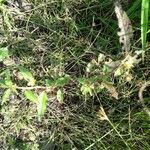Annual herb to 2.5 m, mainly glabrous.. Leaves elliptic to narrowly elliptic, oblong-ovate or ovate, chartaceous, 4.5–14 cm long, 1–5 cm wide, margins serrate with 2 basal serrations prolonged into 2 setae up to 2.3 cm long, rounded at base, acute to acuminate, prominently nerved above and beneath, with setaceous hairs; petioles 1.4–5 cm long, covered with setaceous hairs on upper surface; stipule 0.5–1.6 cm long, glabrous.. Inflorescences of 1–2(–3)-flowered fascicles; peduncles up to 2 mm, glabrous; pedicels up to 2 mm; bracts up to 3 mm long, glabrous.. Sepals 5, 5–8.5 mm long, 1.5–3 mm wide, ciliate at the basal margin.. Petals 5, 5–7 mm long, 1–2 mm wide, pale yellow, oblanceolate, with a short ciliate claw at the base; stamens ∞; ovary cylindric, minutely setulose, to 3.5 mm long.. Capsule cylindric, 10-ribbed, straight or slightly curved on erect pedicels, 2–8 cm long, 0.4–0.7 cm wide, splitting into 5 valves, tapering to a beak.. Seeds angular, 1.5–2 mm long, irregularly ribbed, black.. Fig. 18/10 (fruit, p. 103).
Herbs woody, 1-3 m tall. Stipule ovate-lanceolate, ca. 1 cm; petiole 0.8-3.5 cm, puberulent; leaf blade oblong-lanceolate, 7-10 × 2-4.5 cm, glabrous, basal veins 5, lateral veins 7-10 pairs, base rounded, margin serrulate, apex acuminate. Flowers solitary or 1-3 arranged in cymes, axillary, opposite to leaves; peduncle and pedicel short. Sepals oblong, hairy at base, apex long awned. Petals oblong, as long as or slightly shorter than sepals, stalked at base; stalk ciliate. Stamens on very short androgynophore, glabrous. Ovary 5-loculed, hairy; style glabrous; stigma disk-shaped, lobed. Capsule cylindrical, slightly curved, 10-angled, robust, 5-6-valved, 3-8 cm, apex beaked, with single awn. Seeds obconic, slightly angled, separated by septum. Fl. summer-autumn.
An annual herb. It is upright, branching, and slightly woody. Plants vary in height, shape, leafiness and hairiness. Plants grown for leaves are usually only 30 cm tall. They also have many branches. Leaves are shiny and have leaf stalks. The leaves have teeth along the edge. The tips of the lowest leaves in each side, have long bristle like structures. Small clusters of yellow flowers grow in the axils of the leaves. The fruit are ridged capsules. They can be 7 cm long. These have partitions across them between the seeds. A ripe capsules contains 180-230 seeds. The seeds are dull grey and with four faces and one long point. Each seed has one pale line along it.
Leaf-lamina 3–10 × 2–5 cm., ovate-lanceolate to lanceolate, thin-textured, apex acute, margin serrate or serrate-crenate with the two lowest serrations prolonged into elongated setaceous appendages c. 1 cm. long, rounded at the base, glabrous on both surfaces or setulose on the nerves beneath; petiole up to 5 cm. long, pubescent on the upper side; stipules c. 1 cm. long, setaceous, glabrous.
Capsule 1–8 cm. long, cylindric, appressed to the stem, straight or slightly curved, somewhat torulose, 10-ribbed, 5-valved, with a straight undivided beak c. 1·2 cm. long and inner surface of valves transversely septate.
Inflorescences of small 2–3-flowered cymes opposite the upper leaves; peduncles very short, c. 1 mm. long, glabrous; pedicels 1–2 mm. long; bracts c. 5 mm. long, setaceous, glabrous.
Ovary clasped at the base by a cupular annulus c. 0·5 mm. long with somewhat undulate margin.
Coarse erect annual up to 2 m. tall; young branches somewhat angular or sulcate, glabrous.
Ovary cylindric, 10-ribbed, very minutely setulose and glandular, 5-locular, many-ovuled.
Sepals c. 7 mm. long, linear, thin-textured, bluntly caudate at the apex, glabrous.
Petals yellow, c. 7 mm. long, oblanceolate, with a short ciliate claw at the base.
Coarse, annual herb, 2 m high. Capsule 10-ribbed, 5-valved. Flowers yellow.
A more or less glabrous herb, often woody at the base
Seeds blackish, c. 2·3 × 2 mm., angular.
A common form has laciniate leaves.
Stamens c. 20.
Flowers yellow




